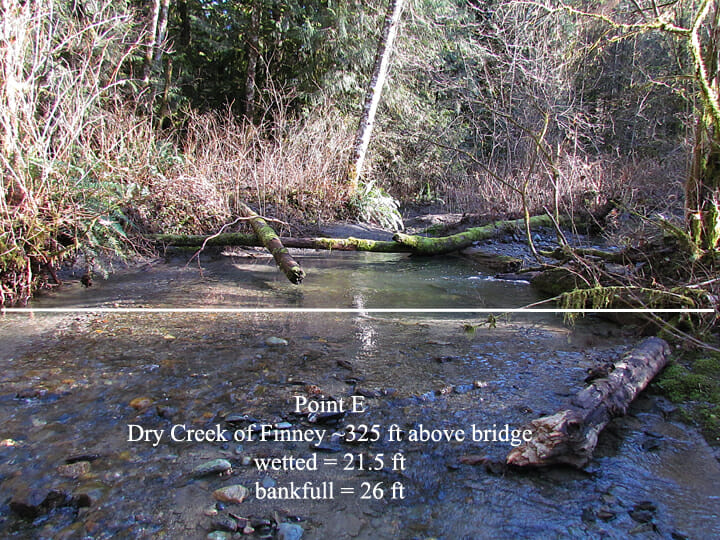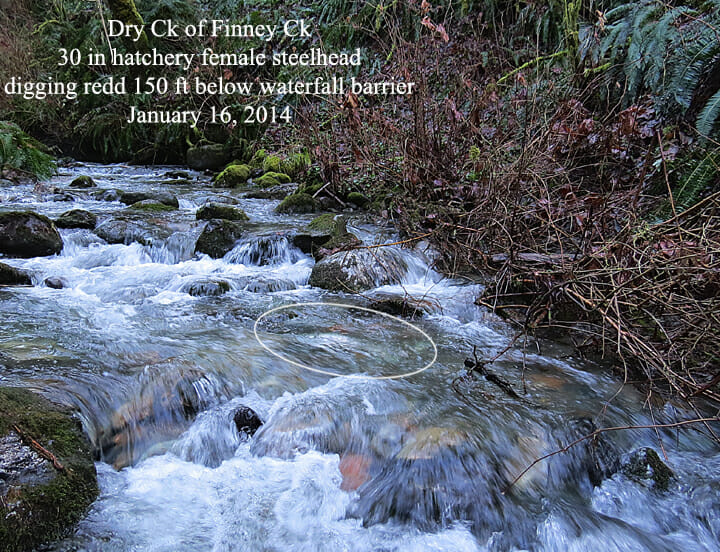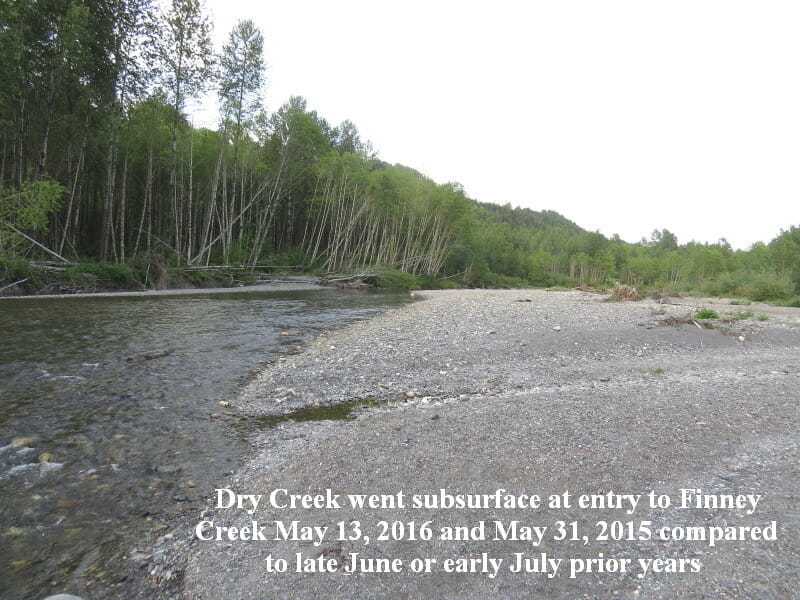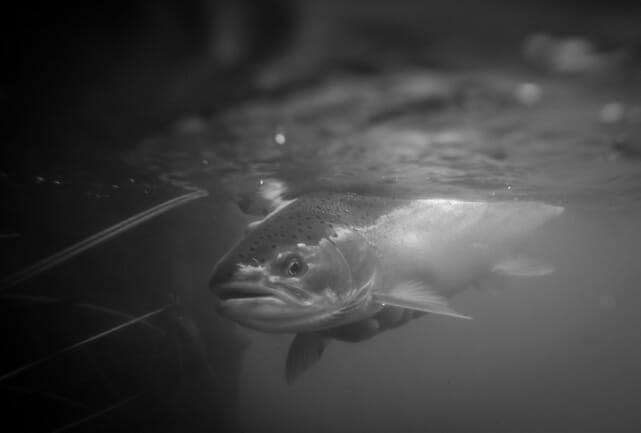Editors note: Every Friday, our science junkies over at Trout Unlimited’s Wild Steelhead Initiative give us an inside look at what’s happening in the world of steelhead science. During the Holidays, we’re running the best of those Science Friday pieces on the TU blog. If you’ve ever spent any time thinking about the sheer game of chance involved in the life-cycle of a wild steelhead, you know this is a world filled with drama, wonder, and downright crazy stuff. And at TU no one knows it better than our science experts. Here are a few of our favorite posts from 2017.
Want more? Follow along at wildsteelheaders.org.
By Bill McMillan
Originally published September 2017
On moving to the Skagit Basin in the summer of 1998, in order to begin some familiarity with such a large watershed I began to fish its tributary streams, which were open to fishing at that time. It was strictly catch-and-release, knowing most of the encounters would be juvenile steelhead. Finney Creek is near our house with a known history of summer-run steelhead. Although I never caught a summer steelhead, I did see one or two and was encouraged that some still remained. However, it was mostly the opportunity to begin learning about the Finney Creek subbasin of the Skagit River that drew me to it, the largest tributary below the Baker River.
 src=”http://www.tu.org/wp-content/uploads/2018/12/dry-creek-1.jpg” />
src=”http://www.tu.org/wp-content/uploads/2018/12/dry-creek-1.jpg” />- One of five stream channel measures made by author at Dry Creek February 15, 2013
Access to the lower 10-11 miles of the anadromous section of Finney Creek was limited to parking at a closed logging road gate about 1.5 above its mouth and then walking up the creek bed 2-5 miles, as time permitted in a day’s fishing, or up the logging road to some point where it could be accessed further upstream. A small tributary entered Finney Creek at the logging road gate. In early June it often still had flowing water, an attractive little stream running through the only remaining section of cedar forest in lower Finney Creek. However, by late June the creek went dry (or more correctly, subsurface). It had no name on maps, so I called it Dry Creek.
When I began doing regular volunteer spawning surveys in several tributaries of the Mid Skagit River in 2010, there was an attraction to Dry Creek on passing by it during winter steelhead spawning surveys at Finney Creek. Many years before I read a 1973 paper by Fred Everest about the entire dependency of Rogue River summer steelhead on small intermittent tributary creeks that went dry by mid-June. It required life histories for early spawning with fry that came out of the gravel with quick downstream outmigration to the mainstem prior to the tributary going dry. Could this similarly be the case at Dry Creek and in the numerous other small intermittent tributaries in the Skagit Basin? On a query to the local WDFW biologist about “Dry Creek” it was indicated a survey had occurred with only a few juvenile coho found.
On February 14, 2013, I decided to make an initial survey of Dry Creek for steelhead spawning. If emergent fry immediately went downstream they may not be detected in the one juvenile sampling that had occurred. Of great surprise, in the lower 250-300 yards surveyed at Dry Creek 5 steelhead redds were found; in 1.5 miles surveyed at Finney Creek 3 steelhead redds were found. “EUREKA” exploded in my mind as I walked back to the truck.
 src=”http://www.tu.org/wp-content/uploads/2018/12/dry-creek-2.jpg” />
src=”http://www.tu.org/wp-content/uploads/2018/12/dry-creek-2.jpg” />- Hatchery female steelhead digging redd at upper Dry Creek, January 16, 2014 accompanied by a wild male resident rainbow (photo by author)
In the many surveys since, steelhead were found to spawn to within 100 feet of the waterfall barrier a half mile above its mouth, but which also included Chambers Creek hatchery origin steelhead as part of the spawning population up until 2015, after which their 2-salt returns ceased in the Skagit Basin due to cessation of hatchery smolt plants. Dry Creek has been found to have as many as 12 steelhead redds, 53 coho redds, and 47 pink salmon redds in peak years during the 5 years of surveys.
Of the five Mid Skagit tributary streams I have regularly surveyed since 2010, two (Dry and Savage creeks) go intermittent in large portions of their lower reaches each year. Mill Creek has gone dry in its lower reaches by mid-June to early July most years since 2010, but not every year. Finney Creek has numerous side channels important for early steelhead spawning that go dry as early as mid to late May. Of the five tributaries regularly surveyed, only O’Toole Creek remains flowing throughout the year. The dry summer of 2017 may be the first that it goes dry in its lower reach.
 src=”http://www.tu.org/wp-content/uploads/2018/12/dry-creek-3.jpg” />
src=”http://www.tu.org/wp-content/uploads/2018/12/dry-creek-3.jpg” />- Dry Creek’s entry to Finney Creek, already dry on May 13, 2016 (photo by author)
Research has projected that as climate change progresses smaller streams will increasingly have intermittent flows. It is also known that logging of watersheds exacerbates this. Wild steelhead, with a great breadth of spawning time and fry emergence, may be the most adaptive Pacific salmonid to the conditions of climate change. In the Skagit Basin, 1978-1981 spawning surveys found that 75% of all steelhead spawned in tributary creeks, not the mainstems. The steelhead future will increasingly be determined by streams like Dry Creek.
 Trout Unlimited’s Wild Steelhead Initiative and associated advocacy group, Wild Steelheaders United is an ambitious and hopeful effort to protect and restore wild steelhead. Today, 70 percent of the major steelhead populations in Oregon, Idaho, Washington and California require federal protection and opportunities to catch wild steelhead have diminished dramatically in many rivers. For more information, go to wildsteelheaders.org or join us on Facebook and Instagram.
Trout Unlimited’s Wild Steelhead Initiative and associated advocacy group, Wild Steelheaders United is an ambitious and hopeful effort to protect and restore wild steelhead. Today, 70 percent of the major steelhead populations in Oregon, Idaho, Washington and California require federal protection and opportunities to catch wild steelhead have diminished dramatically in many rivers. For more information, go to wildsteelheaders.org or join us on Facebook and Instagram.



